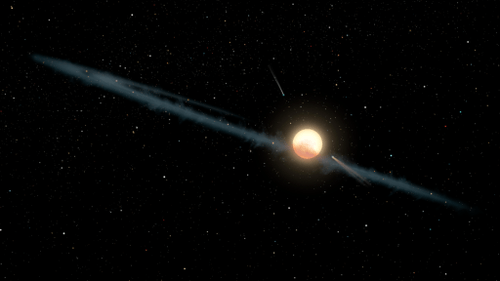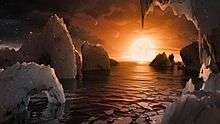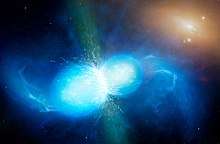RZ Piscium
RZ Piscium (or RZ Psc) is a UX Orionis type variable star[6] 550 light-years (170 pc) away, in the constellation Pisces.[10][6][7] Over the years, the star has been found to brighten and dim erratically, dimming by as much as a tenth of its usual luminosity.[11] RZ Piscium has been found to emit large amounts of infrared radiation,[8] suggesting the presence of a substantial mass of gas and dust orbiting the star, possibly from a "disrupted planet".[5][12]
 Dust and debris orbiting a star (artist's concept) | |
| Observation data Epoch J2000 Equinox J2000 | |
|---|---|
| Constellation | Pisces[1] |
| Right ascension | 01h 09m 42.0523s[2] |
| Declination | +27° 57′ 01.912″[2] |
| Apparent magnitude (V) | 11.29 - 13.82[3] |
| Characteristics | |
| Spectral type | K0IV[3] |
| Variable type | UX Ori[3] |
| Astrometry | |
| Proper motion (μ) | RA: 27.377±0.128[2] mas/yr Dec.: −12.599±0.187[2] mas/yr |
| Parallax (π) | 5.1056 ± 0.1051[2] mas |
| Distance | 640 ± 10 ly (196 ± 4 pc) |
| Details[4] | |
| RZ Piscium A | |
| Temperature | 5,600 K (5,330 °C);[5] 5,620 K (5,350 °C);[6] 5,870 K (5,600 °C)[7] K |
| Age | 30 − 50[7][8] Myr |
| RZ Piscium B | |
| Mass | 0.12 M☉ |
| Other designations | |
| Database references | |
| SIMBAD | data |
Disrupted planet
Because of the infrared excess and rapid light variations, astronomers conclude that:
destruction of one or more massive orbiting bodies has recently occurred within 1 au of the star, and we are viewing the aftermath of such an event along the plane of the orbiting debris.[7]
According to astronomer Ben Zuckerman:
Most sun-like stars have lost their planet-forming disks within a few million years of their birth. The fact that RZ Piscium hosts so much gas and dust after tens of millions of years means it is probably destroying, rather than building, planets.[10]
Observations
In 2017, RZ Piscium was studied using the XMM-Newton satellite, the Shane 3-meter telescope at Lick Observatory in California and the 10-meter Keck I telescope at W. M. Keck Observatory in Hawaii.[7][8] The temperature of the star was found to be about the same as the Sun (5,600 K (5,330 °C)).[5] Further, the star was found to produce about a thousand times more x-rays than the Sun, suggesting that the star is relatively young.[5][11] On the other hand, RZ Piscium was found to contain a relatively small amount of surface lithium, which suggests the star is between 30 − 50 million years old; this is somewhat "old" for a star with so much circumstellar dust.[5][11] Most young stars that are as dusty as RZ Piscium may be producing planets, but given its relatively advanced age, RZ Piscium may be destroying and consuming its planets instead.[11]
In 2020, the red dwarf companion with the mass of 0.12 Solar mass was detected on the projected separation of the 23 AU from the primary star. The incandescence of the companion star thus make up about one third of excess infrared emission previously attributed to the dust.[4]
See also
References
- Staff (2008). "Finding the constellation which contains given sky coordinates". djm.com. Retrieved 22 December 2017.
- Brown, A. G. A.; et al. (Gaia collaboration) (August 2018). "Gaia Data Release 2: Summary of the contents and survey properties". Astronomy & Astrophysics. 616. A1. arXiv:1804.09365. Bibcode:2018A&A...616A...1G. doi:10.1051/0004-6361/201833051. Gaia DR2 record for this source at VizieR.
- Samus, N. N.; Durlevich, O. V.; et al. (2009). "VizieR Online Data Catalog: General Catalogue of Variable Stars (Samus+ 2007-2013)". VizieR On-line Data Catalog: B/GCVS. Originally Published in: 2009yCat....102025S. 1. Bibcode:2009yCat....102025S.
- A bot will complete this citation soon. Click here to jump the queue arXiv:2005.14203.
- Staff (22 December 2017). "Young Star RZ Piscium is 'Eating' Its Own Planets, Astronomers Say". Sci-News.com. Retrieved 22 December 2017.
- Potravnov, I.S.; et al. (March 2014). "An in-depth analysis of the RZ Piscium atmosphere". Astronomy & Astrophysics. 563: A139. Bibcode:2014A&A...563A.139P. doi:10.1051/0004-6361/201423522.
- Punzi, K. M.; Kastner, J. H.; Melis, C.; Zuckerman, B.; Pilachowski, C.; Gingerich, L.; Knapp, T. (21 December 2017). "Is the Young Star RZ Piscium Consuming Its Own (Planetary) Offspring?". The Astronomical Journal. 155 (1): 33. arXiv:1712.08962. Bibcode:2018AJ....155...33P. doi:10.3847/1538-3881/aa9524.
- Reddy, Francis; Garner, Rob (21 December 2017). "New Study Finds 'Winking' Star May Be Devouring Wrecked Planets". NASA. Retrieved 22 December 2017.
- "V* RZ Psc". SIMBAD. Centre de données astronomiques de Strasbourg. Retrieved 22 December 2017.
- Paez, Danny (21 December 2017). "This "Winking" Star is So Hungry it's Feasting on Planets - An appetite of galactic proportions". Inverse innovation. Retrieved 21 December 2017.
- Byrd, Deborah (22 December 2017). "Is the star RZ Piscium eating its planets?". Earth & Sky. Retrieved 22 December 2017.
- Fryling, Kevin (21 December 2017). "IU astronomer's analysis helps discover that a star in the constellation Pisces is a 'planet-eater'". Indiana University. Retrieved 23 December 2017.
External links
- Video (01:00) − RZ Piscium on YouTube, star with unusual light fluctuations (21 December 2017).
- Video (13:46) − "Tabby's Star" on YouTube, a presentation by Tabetha S. Boyajian
- Video (31:00) − "Tabby's Star" on YouTube, a presentation by Issac Arthur


